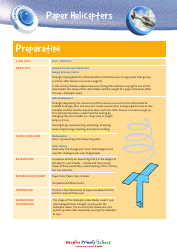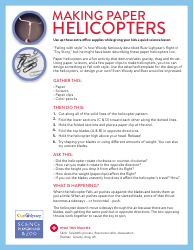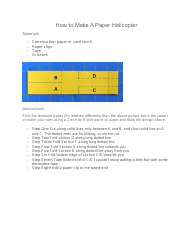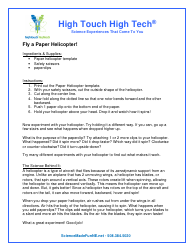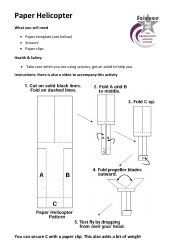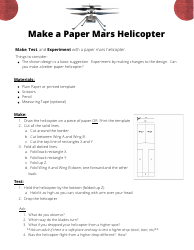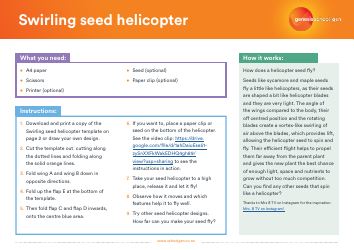Paper Helicopter C.e.r. Template
The Paper Helicopter C.E.R. (Claim, Evidence, Reasoning) Template is a learning tool for students, particularly in science and engineering. This template provides a structured way for students to make a claim, support it with evidence, and explain the reasoning.
In the case of a paper helicopter, students might use this template to hypothesize about how changing a variable (like the weight of the paper or the shape of the wings) would impact the performance of the helicopter (like how quickly or how straight it flies). Then, they would conduct experiments in order to gather evidence to support or refute their claim, and finally explain their reasoning based on their observations.
The goal is to engage students in scientific inquiry and critical thinking skills. The C.E.R. method is part of the Next Generation Science Standards (NGSS) in the USA, but can be used in educational contexts in other countries as well such as Canada, India, or Australia.
The Paper Helicopter C.E.R. Template is typically filed by educators, specifically science teachers. C.E.R stands for Claim-Evidence-Reasoning, a framework often used in scientific teaching to help students form structured arguments or explanations based on their observations or experiments. In this case, the teacher or the student involved in the experiment involving paper helicopters fills out this document to record and analyze their findings.
FAQ
Q: What is a Paper Helicopter C.E.R. Template?
A: A Paper Helicopter C.E.R. Template refers to a document used in science or engineering education that allows students to design, craft, and test paper helicopters using the Claim, Evidence, Reasoning (C.E.R.) framework. This enhances understanding of various physical principles such as gravity, air resistance, and aerodynamics.
Q: What does C.E.R. stand for in a Paper Helicopter C.E.R. Template?
A: C.E.R. stands for Claim, Evidence, and Reasoning. It's a form of structured argument and analysis, particularly used in scientific fields. In the paper helicopter template context, students make a claim (a statement about what will occur), provide evidence (observations from their experiment), and reasoning (explanation of how the evidence supports the claim).
Q: What is the educational purpose of using a Paper Helicopter C.E.R. Template?
A: The purpose of a Paper Helicopter C.E.R. Template is to give students a hands-on, engaging experience to understand basic principles of science and engineering. Crafting paper helicopters helps them grasp concepts like gravity, air resistance, and the effect of design changes on function. The C.E.R. process develops critical thinking, scientific reasoning, and experimental design skills.
Q: How to use a Paper Helicopter C.E.R. Template?
A: To use the template, students first design and craft their paper helicopter. Then they make a claim about how will it perform when dropped. They gather evidence by conducting multiple drops and document observations. Finally, they create reasoning to explain how their evidence supports or refutes their initial claim. Results are then recorded on the C.E.R. Template.



















